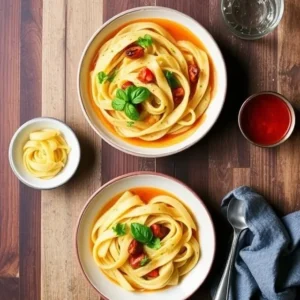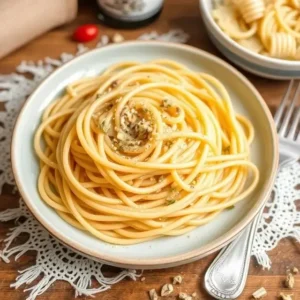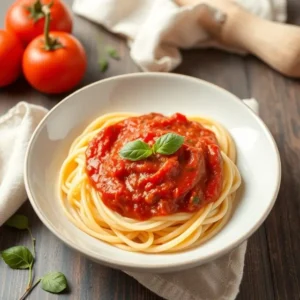
The Ultimate Guide to Making Perfect Pasta Sauce at Home
Hey there, pasta lovers! Ever find yourself craving a pasta dish that tastes like it came straight from an Italian kitchen? Well, you’re in luck. This guide is all about making that perfect pasta sauce right at home. Whether you’re into a classic tomato sauce, a creamy Alfredo, or a fresh pesto, we’ve got you covered. So grab your apron, and let’s dive into the world of pasta sauces!
Understanding the Basics of Pasta Sauce

Key Ingredients for Flavorful Sauces
Making pasta sauce from scratch is like creating a masterpiece—each ingredient plays its part. Tomatoes are the star, offering a robust base and a hint of sweetness. Opt for San Marzano if you can; they’re a game-changer with their rich flavor. Olive oil adds a smooth texture and depth, while garlic and onions provide a savory kick. Fresh herbs like basil and oregano? They’re the finishing touch, elevating your sauce from good to unforgettable.
The Role of Tomatoes in Sauce Making
Tomatoes are the heart of any classic pasta sauce. They bring the essential acidity and color that define the sauce. Whether you’re using fresh or canned, the variety matters. San Marzano tomatoes, for instance, are known for their sweet flavor and low acidity, making them ideal for a balanced sauce. If you can’t find them, any ripe, juicy tomatoes will do. The trick is to let them simmer slowly, allowing the flavors to meld.
Balancing Herbs and Spices
Herbs and spices are the soul of your sauce. While tomatoes provide the body, herbs like basil, thyme, and oregano add layers of flavor that make each bite exciting. A pinch of red pepper flakes can give your sauce a subtle heat, while a dash of sugar might be needed to balance acidity. The key is tasting as you go, adjusting until you hit that perfect harmony. Remember, fresh herbs should be added at the end to preserve their delicate flavors.
Exploring Different Types of Pasta Sauce

Classic Red Sauces and Their Variations
Red sauces are the kings of pasta sauces, known for their rich tomato base and savory depth. Marinara, a quick and simple red sauce, is perfect for those weeknights when you want something tasty without much fuss. Then there’s the Bolognese, a hearty meat sauce that simmers for hours to develop its complex flavors. If you’re feeling adventurous, try Arrabbiata, a spicy version that packs a punch with dried red chili peppers. Don’t forget the variety of homemade pasta sauce recipes, like marinara and slow-cooker ragu, which can be tailored to your taste.
Creamy Alfredo and Cheese-Based Sauces
When it comes to indulgence, creamy Alfredo is hard to beat. Traditionally made with butter and Parmesan, the American version often includes cream for extra richness. Cheese sauces, like Mornay, take a simple béchamel and elevate it with cheeses like Gruyère or cheddar. These sauces are perfect for pairing with fettuccine or penne, providing a velvety texture that clings to every bite.
Pesto and Other Herb-Based Sauces
Pesto is like a taste of summer captured in a jar. Made with fresh basil, garlic, pine nuts, and Parmesan, it’s blended with olive oil for a smooth finish. Variations abound, such as parsley pesto or even sun-dried tomato pesto, each offering a unique twist. These herb-based sauces are not only great on pasta but can also be used as a spread or dip, adding a fresh, vibrant flavor to any dish.
Whether you’re in the mood for something classic or looking to try something new, pasta sauces offer endless possibilities. Experiment with different ingredients and find your perfect match.
Step-by-Step Guide to Making Pasta Sauce

Essential Tools for Sauce Preparation
To make a great pasta sauce, you need the right tools. Start with a sturdy saucepan or skillet—something that heats evenly. A wooden spoon is your best friend for stirring without scratching your pan. A good chef’s knife is essential for chopping onions, garlic, and herbs. A blender or immersion blender can be handy if you prefer a smooth sauce. Lastly, have a ladle for serving and tasting.
Techniques for Perfect Consistency
Getting the right consistency in your sauce can be tricky. If your sauce is too thin, let it simmer uncovered to reduce. For a sauce that’s too thick, add a splash of pasta water to loosen it up. Stirring regularly helps prevent sticking and burning. If you like a chunky sauce, keep your veggies diced larger. For a smoother finish, consider pureeing part or all of the sauce.
Tips for Enhancing Flavor
Flavor is king in pasta sauce. Start by sautéing onions and garlic in olive oil for a rich base. Add herbs like basil or oregano early on to infuse their flavors. A pinch of sugar can balance acidity, especially in tomato sauces. Don’t forget to season with salt and pepper to taste. For a deeper flavor, let your sauce simmer longer, or try adding a splash of red wine or a dash of balsamic vinegar. For a simple yet flavorful approach, consider this simple homemade spaghetti sauce recipe which starts with sautéing onions and includes a bay leaf for added depth.
Pairing Pasta with the Right Sauce
Matching Pasta Shapes with Sauces
Choosing the right pasta shape for your sauce is like finding the perfect dance partner. Each type of pasta has its own personality and texture, making it ideal for specific sauces. For instance, long, thin strands like spaghetti are best friends with smooth sauces like marinara or garlic butter. Their sleek surface allows the sauce to cling just right, ensuring each bite is flavorful. On the other hand, chunky sauces loaded with veggies or meat, like a hearty Bolognese, need a pasta that can hold its own, such as rigatoni or penne. These shapes have ridges and holes that trap the sauce, making every mouthful deliciously satisfying.
Popular Pairings for Classic Dishes
When it comes to classic pasta dishes, some pairings are timeless. Think spaghetti with marinara or clam sauce with linguine. These combinations have stood the test of time because they work so well together. Alfredo sauce finds its match in fettuccine, where the wide noodles are perfect for the creamy texture. Penne alla vodka is another classic, with the tubular pasta capturing the rich, tangy sauce in every bite. And who can forget macaroni and cheese? The small, curved tubes are perfect for holding onto that cheesy goodness.
Innovative Combinations to Try
If you’re feeling adventurous, why not try some innovative combinations? Consider pairing fusilli with a zesty pesto. The spiral shape of the pasta catches the nutty, herby sauce in its grooves, making each twirl a burst of flavor. Or, try orecchiette with a spicy sausage and broccoli rabe sauce. The “little ears” of pasta are perfect for scooping up the chunky bits of sausage and greens. For a sweet and savory twist, pair a brown butter and sage sauce with pumpkin ravioli. The nutty, aromatic sauce complements the rich, sweet filling, creating a dish that’s both comforting and exciting.
Pairing pasta with the right sauce is not just about following tradition; it’s about creating a balance of flavors and textures that makes each dish special. Whether you’re sticking with the classics or venturing into new territory, the right combination can turn a simple meal into a memorable experience.
For more exciting pasta creations, check out our homemade pasta guide where you’ll find recipes and tips to make your pasta nights truly special.
Storing and Reheating Pasta Sauce

Best Practices for Freezing Sauce
Freezing pasta sauce is a great way to save time and effort for future meals. Before freezing, let the sauce cool completely. This prevents ice crystals from forming, which can affect the texture. Once cooled, pour the sauce into freezer-safe containers or bags, leaving about an inch of space at the top for expansion. Label each container with the date of freezing, so you can keep track of its shelf life. Generally, frozen pasta sauce can last up to six months while maintaining its flavor and quality.
Reheating Tips for Optimal Flavor
When it comes to reheating your pasta sauce, the method you choose can make all the difference in preserving its taste and texture. For tomato-based sauces, gently heat in a saucepan over low to medium heat, stirring occasionally. If you’re working with cream or wine-based sauces, heat them over low heat to prevent separation and ensure a smooth consistency. Adding a splash of water or broth can help revive the sauce if it’s too thick after freezing.
Shelf Life and Storage Solutions
In the fridge, homemade pasta sauce typically lasts about 4 to 5 days. To extend its life, consider freezing any portion you don’t plan to use within that timeframe. For longer storage, pressure canning is an option, though it requires specific equipment and knowledge. Always check for any signs of spoilage before using stored sauce, such as off smells or discoloration. Keeping these tips in mind will help you enjoy your pasta sauce at its best, whenever you’re ready to use it.
Troubleshooting Common Pasta Sauce Issues
Fixing a Sauce That’s Too Thin or Thick
Ever ended up with a pasta sauce that’s more like soup or a paste? It’s a common problem, but there’s an easy fix. If your sauce is too thin, try simmering it longer on low heat to evaporate excess liquid. Alternatively, a spoonful of tomato paste or cornstarch mixed with a bit of cold water can thicken it quickly. For a sauce that’s too thick, gradually add a little pasta water or broth until you reach the right consistency.
Adjusting Seasoning and Acidity
Finding the right balance of flavors can be tricky. If your sauce tastes too acidic, a pinch of sugar can counteract the tartness. On the flip side, if it’s too sweet, a splash of vinegar or a squeeze of lemon juice can add the needed acidity. Always taste as you go, and adjust salt, pepper, and herbs according to your preference.
Rescuing a Burnt or Overcooked Sauce
Burnt sauce can be a disaster, but it’s not always a lost cause. First, don’t stir the burnt bits from the bottom. Carefully transfer the unburnt sauce to a new pot, leaving the burnt layer behind. To mask any remaining burnt flavor, try adding a bit of cream, butter, or even a splash of wine. If the sauce is simply overcooked and too concentrated, adding fresh tomatoes or a bit of water can help bring it back to life.
Remember, the best pasta sauces are made with love and patience. Don’t rush the process, and don’t be afraid to experiment with flavors. Every mistake is just a step closer to your perfect sauce.
Wrapping It Up: Your Pasta Sauce Journey
So there you have it, folks! Making pasta sauce at home isn’t just about following a recipe; it’s about experimenting and finding what works for you. Whether you’re a fan of the classic tomato sauce or prefer something creamy like Alfredo, the key is to enjoy the process. Remember, it’s okay to make mistakes along the way. Each attempt brings you closer to your perfect sauce. So grab your ingredients, get cooking, and most importantly, have fun with it. Who knows, you might just discover a new family favorite!
Frequently Asked Questions
What are the key ingredients for making pasta sauce?
The main ingredients for pasta sauce include tomatoes, garlic, onions, olive oil, and herbs like basil and oregano. You can also add meat, cheese, or vegetables to enhance the flavor.
How do I fix a pasta sauce that’s too thin?
To thicken a thin pasta sauce, you can simmer it for a longer time to reduce the liquid. Adding a bit of tomato paste or cornstarch mixed with water can also help thicken it.
Can I use fresh tomatoes instead of canned ones?
Yes, you can use fresh tomatoes. Just make sure to peel and crush them before cooking. Fresh tomatoes might give a different texture and flavor compared to canned ones.
How can I make my pasta sauce taste better?
To enhance the flavor of your pasta sauce, try adding a splash of red wine, a pinch of sugar, or some fresh herbs. Sautéing onions and garlic before adding them to the sauce can also boost the taste.
What’s the best way to store leftover pasta sauce?
You can store leftover pasta sauce in an airtight container in the refrigerator for up to 4 days. For longer storage, freeze it in a freezer-safe container for up to 3 months.
How do I reheat pasta sauce without losing flavor?
Reheat pasta sauce slowly over low heat on the stove, stirring occasionally. Adding a little bit of water or broth can help maintain its consistency and flavor.






1 thought on “The Ultimate Guide to Making Perfect Pasta Sauce at Home”